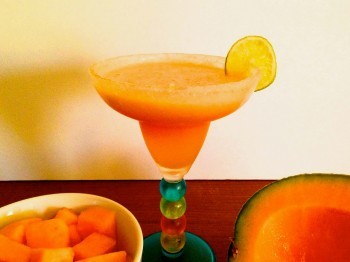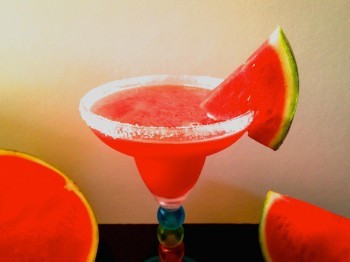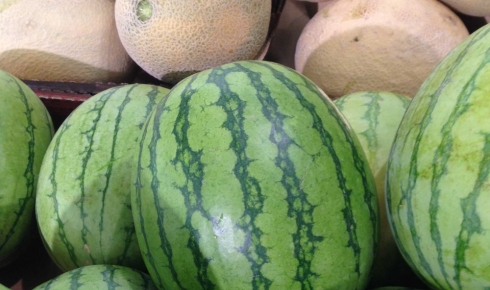Frozen Melon Margaritas for Fall
by Linda Stewart
Although melons can be found all year-round in today’s marketplace, I find the sweetest ones arrive in the late summer and early fall. While I was trying to think of an out-of-the-ordinary, fall-appropriate cocktail, my friend Donna told me about a wonderful watermelon margarita she had on a recent family reunion trip to Hawaii. She gave me the ingredients, and after adding my own touches, I devised a recipe for frozen watermelon and cantaloupe margaritas.
 The melon margarita recipe also gives me an opportunity to address a question I am often asked, “What kind of tequila is best to use in margaritas?” To answer that question, here is a quick review of the spirit. Like champagne, tequila has regional authenticity requirements. Tequila must come from the blue agave plant in the Mexican state of Jalisco and only a very few other areas, where fertile, red volcanic soil is conducive to producing optimal growing conditions. Blue agave that are grown in the Jalisco highlands of Los Altos tend to have a sweeter, fruitier flavor. Plants that are grown in the lowlands in the Tequila Valley are inclined to be earthier and more herbaceous. Agave juice is extracted from the middle part of the plant, called the piña, so named because it resembles a pineapple. The piñas are cooked in stainless steel or wooden-type pressure cookers.
The melon margarita recipe also gives me an opportunity to address a question I am often asked, “What kind of tequila is best to use in margaritas?” To answer that question, here is a quick review of the spirit. Like champagne, tequila has regional authenticity requirements. Tequila must come from the blue agave plant in the Mexican state of Jalisco and only a very few other areas, where fertile, red volcanic soil is conducive to producing optimal growing conditions. Blue agave that are grown in the Jalisco highlands of Los Altos tend to have a sweeter, fruitier flavor. Plants that are grown in the lowlands in the Tequila Valley are inclined to be earthier and more herbaceous. Agave juice is extracted from the middle part of the plant, called the piña, so named because it resembles a pineapple. The piñas are cooked in stainless steel or wooden-type pressure cookers.
 Based primarily on the aging process, five different types of tequila are produced. Blanco (Silver) is bottled after distillation (most tequilas are distilled twice) or sometimes aged for up to two months in stainless steel barrels. The other tequilas are usually aged in North American white oak barrels, which have been formerly used to age whiskeys. Reposado is “rested” or aged a minimum of two months to a maximum of one year. Joven or Oro (Gold) Tequila is a blend of Silver Tequila and Reposado. Añejo is considered “vintage” tequila and is aged for one to three years. As of 2006, the tequila industry has established a new designation, Extra Añejo, which is tequila that is aged for at least three years. Because of their more intense agave flavor, Silver and Reposado are the recommended tequilas for use in mixed drinks. Añejo and Extra Añejo, with their richer, more complex flavors, are better served neat. The most important factor in selecting tequila is to purchase only tequila made from 100 percent blue agave.
Based primarily on the aging process, five different types of tequila are produced. Blanco (Silver) is bottled after distillation (most tequilas are distilled twice) or sometimes aged for up to two months in stainless steel barrels. The other tequilas are usually aged in North American white oak barrels, which have been formerly used to age whiskeys. Reposado is “rested” or aged a minimum of two months to a maximum of one year. Joven or Oro (Gold) Tequila is a blend of Silver Tequila and Reposado. Añejo is considered “vintage” tequila and is aged for one to three years. As of 2006, the tequila industry has established a new designation, Extra Añejo, which is tequila that is aged for at least three years. Because of their more intense agave flavor, Silver and Reposado are the recommended tequilas for use in mixed drinks. Añejo and Extra Añejo, with their richer, more complex flavors, are better served neat. The most important factor in selecting tequila is to purchase only tequila made from 100 percent blue agave.
For the following margaritas, the cantaloupe and watermelon are first cut into 1½ -inch to 2-inch cubes and then frozen overnight. Using frozen melon precludes the need to use ice cubes, which dilute the drink. Rimming the glass with a combination of salt and sugar adds a nice balance to the drink’s flavor.
Melon Margaritas
3 cups cantaloupe or watermelon, cut up and frozen
6 oz. tequila (Silver or Reposado, 100% blue agave)
4 oz. fresh lime juice
2 oz. triple sec
2 tsp. agave syrup
salt
sugar
fresh lime
Place melon, tequila, lime juice, triple sec, and agave syrup in a blender and process until smooth. Combine salt and sugar and spread onto a plate. Rub a lime wedge around the rim of a margarita glass, and then dip the glass into the salt-sugar mixture. Makes two Melon Margaritas.

